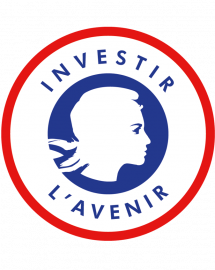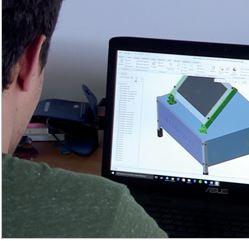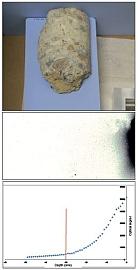Innovative pre-disposal projects: Characterization of decommissioning sites and facilities
The "Investing for the future" funding enables Andra to support innovative initiatives to optimize, upstream of storage, the management of radioactive decommissioning waste. The project presented on this page are such projects related to Characterization of decommissioning sites and facilities.
Endowed with nearly 47 billion euros, the Investissements d'Avenir program is an investment program of the French State, set up in 2010 to finance innovative and promising projects on the territory, with a principle of co-financing for each project.

Andra benefits, under the "Nuclear of Tomorrow" part of this program, from an allocation of € 75 million to develop innovative radioactive waste management solutions, upstream of storage: characterization, treatment, conditioning of Radioactive waste. By participating in these projects, Andra ensures that the constraints and requirements of storage are taken into account at the earliest, from the very design of radioactive waste treatment or conditioning solutions.
Temporal
Gamma-ray imaging spectrometer based on a temporal imaging method for nuclear decommissioning
The TEMPORAL project is an industrial research project aimed at developing a camera that can detect gamma rays and visualise their location and intensity on an image of the mapped area (Compton camera).
It will be used for:
- taking images of radioactive waste drums in order to check their contents (inventory, location of "hot points");
- taking images of a site or large pieces of equipment in the field of decommissioning in order to identify potential contamination zones;
- being installed on an automatic sorting line in order to identify contaminated elements
To learm more on the project
MAUD
Measurement by Digital Autoradiography

The MAUD project's main aim is to improve the detection of radionuclides that are difficult to measure and make it possible to provide in situ measurements via the development of a transportable system that combines activity level measurement and characterization of radionuclides.
This industrial project aims to obtain images of the location of difficult-to-measure radionuclides on solid materials found in nuclear waste generated by decommissioning (mainly concrete, plastic and metal). Information from these characterizations will help better plan decommissioning sites and reduce the doses received by workers as much as possible. In-depth and optimized characterization will save time and money in processing decommissioning waste.
To learm more on the project
CAMRAD
High-performance radiation-hardened imaging system
the CAMRAD project objective.
Unlike conventional products based on "offthe- shelf" components, CAMRAD intends to optimise design and develop new, more radiation-resistant, technological building blocks for each camera sub-system. That way, all hardening-related constraints will be taken into account across all of this new camera's development stages.
CAMRAD is looking to develop a camera with a much greater resistance to ionising radiation than existing products (cumulative dose of 1-10 MGy) with performance levels not generally found on this market (colour image, high resolution, compact design, etc.).
To learn more on the project...
ComptonCAM
Development of an ultra-sensitive portable gamma camera to locate and characterise post-dismantling radioactive waste
image of a radioactive source observed
using the ComptonCAM
While the majority of gamma cameras currently used in the nuclear industry work by blocking some of the incident gamma rays, the ComptonCAM project aims to develop an optimal performance Compton-type gamma camera by using several innovative detectors to analyse all the incident radiation. The development and final design of the camera involve highly detailed digital simulation work performed using computer tools initially designed for preparing future gamma-ray astronomy space instruments. The ComptonCAM also intends to innovate in the following areas:
- development of ultra-low-noise and highly compact electronic systems for picking up gamma detector signals;
- use of an artificial neural network (algorithms) to optimise the response to gamma photon detectors;
- production of an optimal data acquisition and processing system to generate a real-time image of the gamma-emitters in the broad field of view observed.
To learm more on the project
INSPECT
Online and remote dosimetry for the inspection of nuclear equipment and infrastructure
The INSPECT project aims to develop a radioactivity measurement system in the form of a cable that can be easily transported into difficult-to-access zones. This system is based on Optically Stimulated Luminescence - Fibre Optics (OSL/FO), which uses a luminescent material attached to the tip of an optical fibre. This technology has the following advantages:
using an OSL system
- It can be used for operational dosimetry (direct online reading of radiological measurements).
- It is not sensitive to electromagnetic disturbances, so does not require shielding like other technologies, meaning that a smaller version would be possible.
- It can be used very remotely (long-distance measurements with the measurement analysis unit placed outside of the radiological zone) and to measure a wide range of dose rates (from several μGy/h to several Gy/h).
The feasibility of these remote inspections has already been demonstrated by CEA LIST on several dismantling sites (APM and UP1 in Marcoule, new-generation reactor in Cadarache) using point and radiation-resistant OSL/FO sensors. For these tests, the sensors were placed on the tip of a reinforced optical cable and displaced point by point to reconstitute the facility’s radiological profile.
To learm more on the project
TOMIS
In Situ Low Dosimetric Impact Multi-Energy Tomograph
The low dosimetric impact multi-energy TOMograph In Situ (TOMIS) project proposes:
in a permanent bunker on a dense package:
X-rays and tomographic sections. Internal
structures, material distribution and defects
can be detected by these examinations
- to develop a powerful tomography tool that can be implemented in situ, for the physical characterization of old waste, decommissioning waste, as well as possible parts of structures and equipment;
- to constitute a non-destructive tool which supplements radiological characterization by combining it with measurement methods such as gamma spectrometry and neutron measurement.
The particularity of TOMIS, which will make it a unique tool, is its mobile and adaptable nature, so that it can be used directly on nuclear and nonnuclear sites storage, disposal, dismantling, etc. The TOMIS tomograph can thus be moved as close as possible to containers, which are sometimes difficult to transport. In particular, the mobility of the TOMIS system requires a drastic reduction in its dosimetric impact, linked to the use of a linear electron accelerator.

